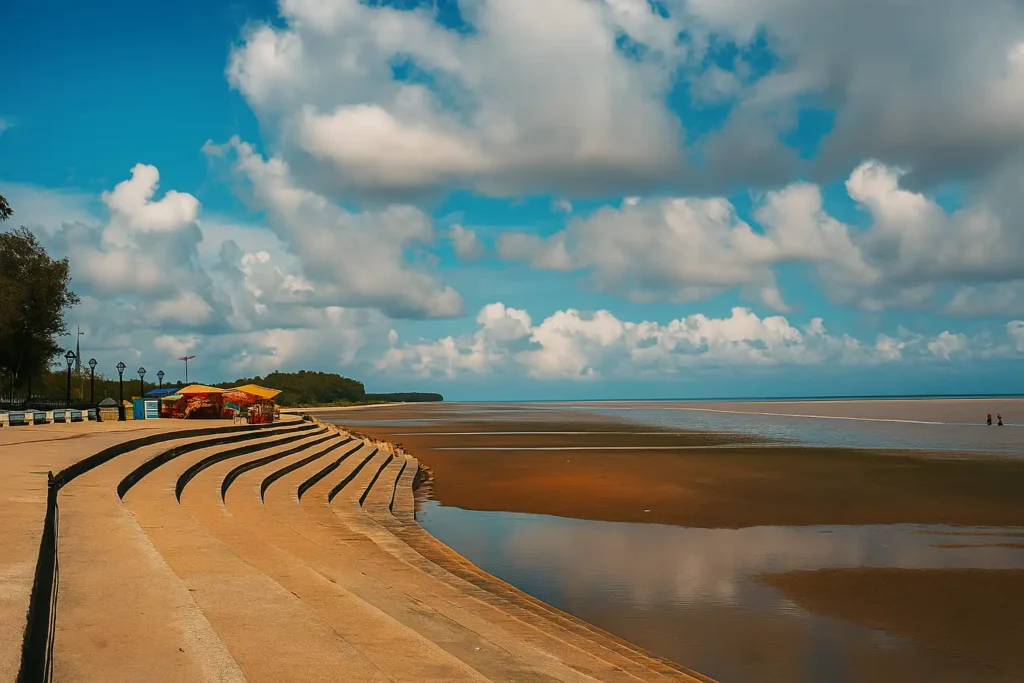
Table of Contents
What Makes Chandipur Beach So Unique?
Chandipur Beach, often called “Chandipur-on-Sea,” is located in Balasore district, Odisha. Interestingly, what sets it apart is that the sea literally vanishes before your eyes. During low tide, the water recedes as much as 5 kilometers into the Bay of Bengal—only to return rhythmically with the high tide. It’s not just a beach; it’s a natural phenomenon that feels almost magical.
Additionally, besides being a hidden gem for tourists, Chandipur also serves as an exceptional research ground for geologists and marine biologists.Location & Accessibility: Easy to Reach, Hard to Forget
Planning a visit? Here’s everything you need to know to get there with ease.
- Location: Chandipur is situated at 21°47′N 87°01′E, just 16 km from Balasore Railway Station.
- By Road: Moreover, it is well connected via roads from Bhubaneswar (230 km) and Kolkata (314 km).
- By Train: Additionally, trains from cities like Kolkata, Chennai, Delhi, and Bhubaneswar stop at Balasore.
- By Air: Furthermore, the nearest airports are Bhubaneswar and Kolkata.
- Bonus: Interestingly, it’s also near Balaramgadi, where the Buribalam River meets the sea—a scenic estuarine spot.
Nature & Climate: Tropical Serenity
Expect a warm, breezy, and lush landscape—perfect for beachgoers and nature lovers.
- Climate: To begin with, it’s tropical—hot summers, mild winters. Best time to visit: October to March.
- Temperature Range: On average, the temperature hovers around ~26.7°C annually.
- Rainfall: Notably, rainfall peaks in August (~339 mm); meanwhile, January sees the least rain (~8 mm).
- Vegetation: As a result of the unique tidal system, coastal plants and vibrant marine biodiversity thrive here.
Explore the Natural Wonders of Chandipur
Tidal Flat Environment
This is where the magic happens. Exposed during low tide, these flats are rich in sedimentary features:
- Wave Ripples: Firstly, beautiful symmetrical patterns left by retreating tides.
- Mud & Sand Volcanoes: Secondly, natural mini-cones of sediments.
- Algal Mats: Lastly, microbial layers that help preserve sedimentary structures.
Beach Environment
Split into Foreshore and Backshore:
- Foreshore: To begin with, features like backwash ripples, rill marks, and rhombic ripples.
- Backshore: In contrast, only active during storms. Here, you’ll find larger grain sediments, shell beds, and crab burrows.
Aeolian Environment
- Aeolian Ripples: Formed by wind on dry sand
- Setulf Structures: Inverted flute-like ridges
- Grain Flow and Fall: Caused by wind or gravity-based movement
Biodiversity & Shell Safari
- Horseshoe Crabs: Rare and ancient species found here
- Shell Varieties: From Mactra luzonica to Tonna and Natica tigrina
- Crab Burrows: Varying sizes and orientations depending on moisture
- Bio-Zonation: Shell sizes and species differ in foreshore vs. backshore due to wave energy
Trail Marks & Fossil Traces
Nearby Attractions
- Balaramgadi Estuary: Just 2 km away
- Abdul Kalam Island (Wheeler Island): India’s missile testing range (viewable from afar)
- Sitakund Waterfall: In Mayurbhanj, great for a day trip with sedimentary rock wonders
Why Geologists & Students Flock to Chandipur
Chandipur is an open textbook for students of sedimentology, paleontology, and marine ecosystems. With its diverse sub-environments, it offers insights into:
- Tidal Dynamics: Firstly, it reveals how rhythmic tidal movements shape the coastal landscape.
- Marine Life Behavior: Moreover, it provides observable patterns of species adapting to tidal rhythms.
- Environmental Mapping: Finally, it serves as a live case study for tracking coastal environmental changes.
People Also Ask (FAQs)
1. Why is Chandipur Beach famous?
2. Is it safe to visit Chandipur Beach?
3. What is the best time to visit Chandipur?
4. Can you walk on the seabed at Chandipur?
5. Are there hotels near Chandipur Beach?
Final Words
So, pack your bags, grab your camera, and set off to Chandipur Beach—Odisha’s enchanting coast where the ocean plays hide and seek.
Then, share this blog with your friends and inspire them to witness the wonder of Chandipur Beach!

